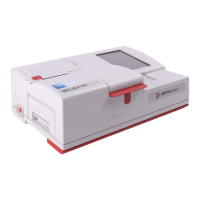Operator’s Manual – OPTI CCA-TS2 PCO2-B-1
ANALYTES PCO
2
(Dry Sensor)
PCO
2
(Dry Sensor - B-Lac Cassette)
Clinical Signicance
1
The PCO
2
value of arterial blood is used to assess how well the body eliminates carbon dioxide, a
by-product of metabolism. A PCO
2
value below the normal range is termed respiratory alkalosis and
indicates hypocapnia, a condition caused by increased alveolar ventilation such as hyperventilation.
An arterial PCO
2
above the normal range is termed respiratory acidosis and indicates hypercapnia, a sign
of ventilatory hypoventilation and failure, resulting from cardiac arrest, chronic obstructive lung disease,
drug overdose, or chronic metabolic acid-base disturbances.
Measurement Principle
The PCO
2
sensor measurement principle is based upon placing a pH optode behind a gas-permeable
membrane to measure a hydrogen concentration change in the internal solution when CO
2
permeates
through the gas permeable membrane. The reaction sequence is outlined below.
CO
2
+ H
2
O H
2
CO
3
H
+
+ HCO
3
-
The hydrogen concentration change is measured by an optical pH sensor. The change in the hydrogen ion
concentration is proportional to the carbon dioxide partial pressure in the specimen.
Measurement Range
Range Resolution (Low/High) Units
10 to 200 1/0.1 mmHg
1.33 to 26.66 0.1/0.01 kPa
Standard Reference Cassette (SRC) Limit Values
LOW NORMAL HIGH Units
70.0 ± 2.0 40.0 ± 2.0 20.0 ± 2.0 mmHg
9.33 ± 0.27 5.33 ± 0.27 2.67 ± 0.27 kPa

